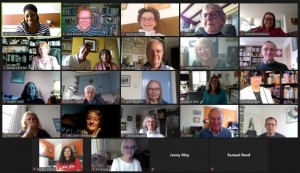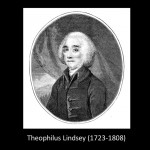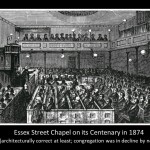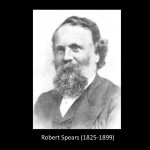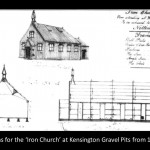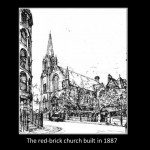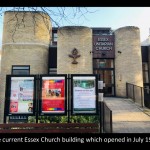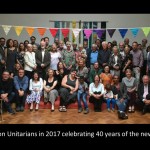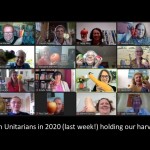Sermon #43 (27th September 2020 at Essex Church / Kensington Unitarians)
I’ve got something a little bit different for you in the sermon-y bit this morning. A few weeks ago, as part the requirements of my ministry training, I had to give a short presentation on the history of this congregation. I’m about to give you a very abridged summary of it (in about 6 ½ minutes, I think) and afterwards I’ll tell you why. I think at least a few people here today will be familiar with the story of Essex Church (otherwise known as Kensington Unitarians) but in truth – London being what it is – and given our newly broadened ‘catchment area’ since we’ve been meeting on Zoom – the turnover of people coming to our services is pretty high and it’s likely many of you haven’t heard the story before. I’m going to show some slides of our illustrious forebears and their impressive hair and beard arrangements to keep it lively! But I will also keep it brief.
Let me introduce you to this fine fellow (and his bouffant hair): Theophilus Lindsey. He’s a very significant figure in the history of this congregation and Unitarianism in general. He started out in the Church of England, was ordained in the 1740s, but over the decades that followed his conscience began to nag at him, particularly in relation to the requirement that all clergy subscribe to the Thirty Nine Articles, a statement defining Anglican (i.e. Trinitarian) doctrine. He’d started coming round to a unitarian-ish position, and though he tried to reform the church from within, by 1773 he resigned as vicar of Catterick (Yorkshire) and came to London. This was a big deal! He was giving up his livelihood to do something pretty radical at that time. His friends egged him on to start a new congregation of like-minded people down south. He rented a room from an auctioneer in Essex House, near the Strand, and held the first service in 1774.
This is approximately what it would have looked like (though this picture is of a later event). There were 200 people at that first gathering, including Benjamin Franklin, Joseph Priestley, and a number of other big political and legal names of the time, even though at this point openly anti-Trinitarian preaching was still technically against the law. Supposedly government agents were present to keep an eye on things but the press generally reported sympathetically. Theophilus Lindsey’s well-off supporters chipped in to buy the freehold of Essex House and a chapel – the Essex Street Chapel – was built on the site and flourished for the next half century. However, over time, the demographics of the city changed, and people moved to the suburbs. By the 1880s the congregation was in decline and they were thinking about closing altogether.
But there’s more than one strand to our story! Meet Robert Spears (less hair; more beard). Another very significant figure in Unitarian history. He came from the north-east, was largely self-taught, started out a Trinitarian with the Methodists but became convinced that the Bible was thoroughly Unitarian and went about vigorously spreading this bible-based Unitarianism. He also ended up down south and founded several congregations including one in west London. The Kensington congregation started off meeting in rented rooms in 1867 and moved around a bit but within seven years they’d picked up enough momentum to move to a settled site.
James Clark Lawrence, later Lord Mayor of London, bought some land in what was known as the Kensington Gravel Pits and a temporary ‘Iron Church’ made of corrugated iron was put up. By the 1880s the congregation was well on the way to raising funds for a new, larger church. And – this is where the two strands of our story join together – this is the point where Lindsey’s original Essex Street Chapel was shrinking due to the population moving out of central London. So to cut a long story short, the two congregations decided to merge on the Kensington site, which hastened the move to demolish the old Iron Church and build a fancy new gothic building.
And from this point the congregation became known as ‘Essex Chapel’, later ‘Essex Church’, as a way to assert continuity with the first Unitarian congregation that Lindsey had started. Only bits and pieces of records from this time have survived but in his book telling the history of our congregation Raymond Williams looks back to the 1880s, and makes a significant comment: ‘it appears that most lived within walking distance of the church… but it is equally evident that, even in those years, many left the district after a few years, and the area was even then assuming its modern character as a dormitory for birds of passage.’ Not many of us live in walking distance any more but I was surprised to hear that even ~150 years ago the turnover of people was high. Still, they expanded their activities in the early 20th century, and had a huge Sunday school, but after the war the numbers started to decline again, and the building started to show its age. The church was a bit too big for the congregation so they decided to demolish and redevelop in the 1970s. For a few years the congregation met in hired rooms again. The theological centre of gravity started to shift – not quite so Christian-centred – gradually more humanist influences.
And here’s the present-day building which many of us know, and love, and currently miss. It was opened in 1977 and is a beautiful, flexible, quirky space, with an annoyingly leaky roof. Now to squeeze this story of our history into 6 ½ minutes of course I’m going to leave a lot out. From being here 21 years myself, I’m already conscious of all the history of the church that has unfolded before my eyes, all the devoted and influential figures who’ve passed through this congregation over the years and given so much of themselves to keep the show on the road. And that made me start to think a bit about all that doesn’t get written down for posterity.
We had a jolly good party back in 2017 to celebrate the 40th anniversary of the building. But that’s one of the things I found strange when I was reading up on our congregation’s history: So much of it was about the buildings. And a fair amount about ministers and notable figures. But on the whole, I read that list of names, and didn’t feel that I knew much about them really. It’s harder to get a sense of the real people, the congregational life, the deeper stuff that actually draws us together, and which has presumably drawn people to Essex Church for 246 years now. Because as much as we love our church building – that’s not primarily what we come for, is it? And we can say that with some confidence now, having been mostly ‘in exile’ for the last 6 months.
So I really wanted to include one more slide. To affirm that even while we’re not meeting in our beloved building we’re still in continuity with that first congregation from Essex Street, and the Iron Church, the Gothic Church, and the rented rooms. This is part of the same story. Us mucking about with our comedy vegetables on Zoom last week for our virtual harvest festival.
Now, you might wonder why I’ve given you that whistle-stop tour of our church’s history. Here’s why. In today’s service we’re just beginning to explore the question: ‘Why Are We Here?’ And it occurred to me that one significant part of the answer to this question is: ‘We are here because, when we – each of us here today – when we went in search of a spiritual home, this church was just sat there waiting for us. Ready for us to discover’.
Someone founded this congregation – Theophilus Lindsey broke away from the mainstream to gather that very first Unitarian chapel on Essex Street – and a continuous chain of hands has sustained it ever since, kept it alive over the last 246 years, most of them not recorded in the history books, they remain unheralded and anonymous, but faithful stewards all the same. And because of them – their vision, their labour, their care – the congregation has survived so that when each one of us went looking for a progressive religious home, whether that was 40 years ago, or 40 minutes ago, or somewhere in-between, it was still here for us to stumble across. For some of us – me, at least – that’s been a life-changing gift, a treasure handed down the ages. And now it’s our turn. It’s up to us to be custodians of this church, this congregation, this Unitarian tradition, and keep it in good nick for the generations yet to come. Like ‘John’, the character in the story that Antony read for us earlier, it’s up to us to show up and be here to welcome the next person that needs us – that needs this progressive religious community – and whose life might be changed by it.
The church hasn’t stayed the same over all that time – of course it hasn’t. We’ve been through all those church buildings – and times without a building. The emphasis of the theology has shifted – and although we’ve kept the name ‘Unitarian’ – we’ve come to draw on a much wider range of sources than the bible-based faith of our forebears. The shape and the style of the worship has changed radically – and it is still evolving. Despite all these changes, though, there’s something constant and enduring that remains. If you look back through our story, some key values emerge, some principles and purposes. Many of those values are directly inherited from the Christian tradition we came out of, even if the religious language we typically use has changed a bit over the intervening years.
Maybe we don’t make reference to the commandment to ‘love God and love our neighbour’ – but I’d suggest that the spirit of this commandment, the Spirit of Love itself, is still at the very heart of all we do – even if some of us might prefer to substitute ‘Good’ for ‘God’, and talk about the very human acts of kindness and solidarity that are an expression of our faith. Maybe – in this congregation, at least – we Unitarians don’t talk about the ‘Kingdom of God’ so much these days (though personally it’s still a phrase I love) but we might speak instead of the ‘Beloved Community’ when referring to the better world we dream of, a better world which is ‘at hand’, we can catch glimpses of, whenever acts of love and justice are carried out.
Why Are We Here? I could summarise with three ‘Ps’: Place, People, and Purpose. When I say PLACE I mean: there was somewhere – either a building or virtual space – for us to gather. For you and me to walk in, or log in, to for the first time. A place that was waiting for us. When I say PEOPLE I mean: there has been a continuous community of those who were willing – like that faithful chap ‘John’ in the reading that Antony gave for us earlier – to give their hearts to a particular community – offering care, and mutual support, and keeping the show on the road. And when I say PURPOSE I mean: the church is more than just a social club for ‘people like us’. There is something we are called to do in the world, values we share, a love that we embody. Personally, there are reasons why I came here, and not to the Anglicans, or the Buddhists, or a Philosophy class (worthy as all those gatherings are). It matters what we stand for, what our particular mission is. And each week, when the PEOPLE are gathered in the PLACE, we call each other back to this greater loving PURPOSE.
There’s a lot more we could say about why we’re here – as individuals and collectively – and as this is just part one of a two-parter I’ll leave you to ponder that question for yourself in the week ahead (before we hear more from Jeannene, Charlotte, and Roy next Sunday). But for now I’ll end with an echo of our opening words by Kimberlee Anne Tomczak Carlson:
It is not by chance that you arrived here today.
You have been looking for something larger than yourself.
Inside of you there is a yearning, a calling, a hope for more,
A desire for a place of belonging and caring…
And so, you began seeking a beloved community:
A people that does not put fences around love.
A community that holds its arms open to love’s possibilities.
A heart-home to nourish your precious soul and share your gifts. Welcome home. Amen.
Sermon by Jane Blackall
An audio recording of this sermon is available:
A video recording of this sermon is available:
A video recording of the following week’s congregational service is also available:

